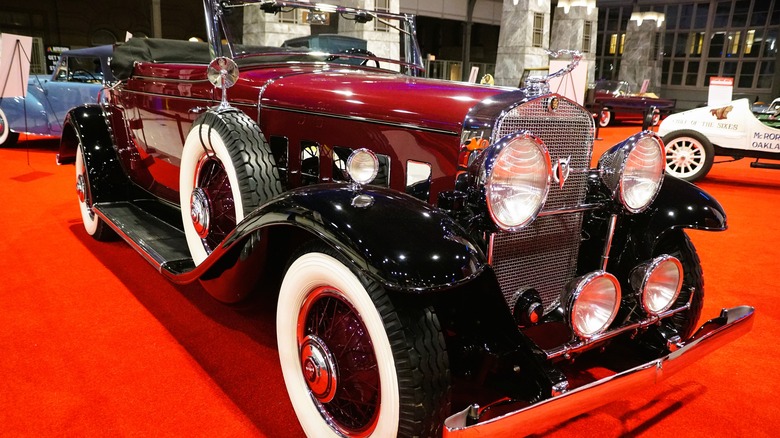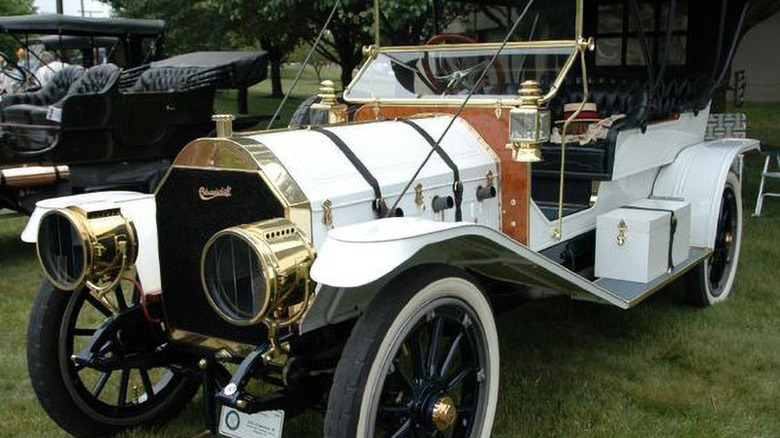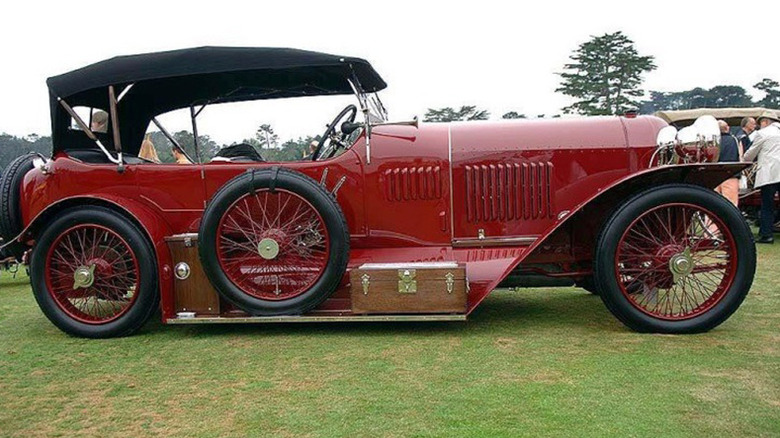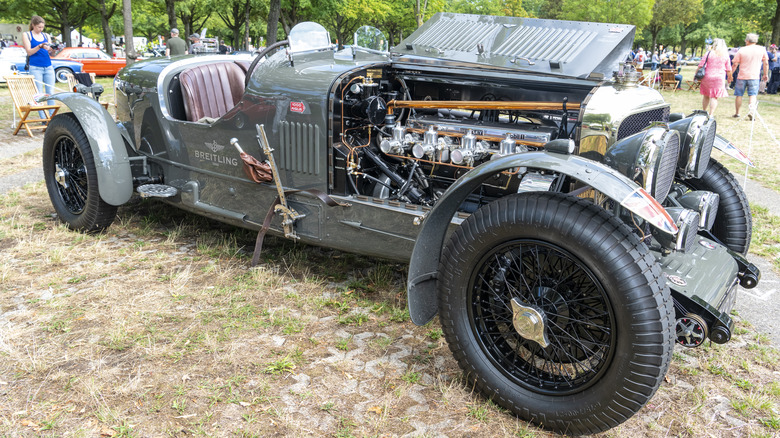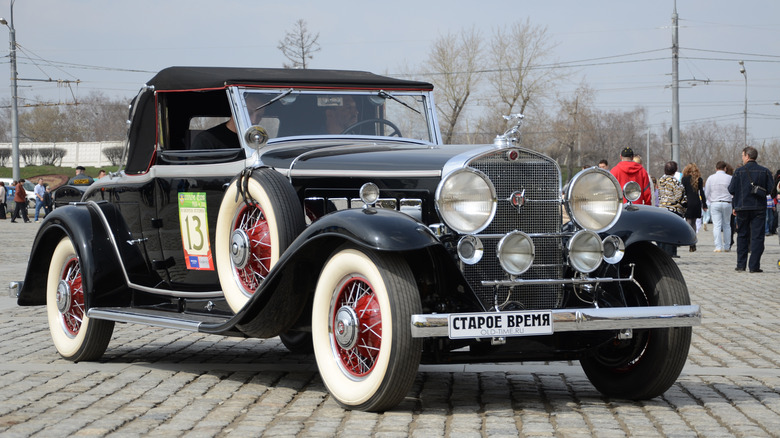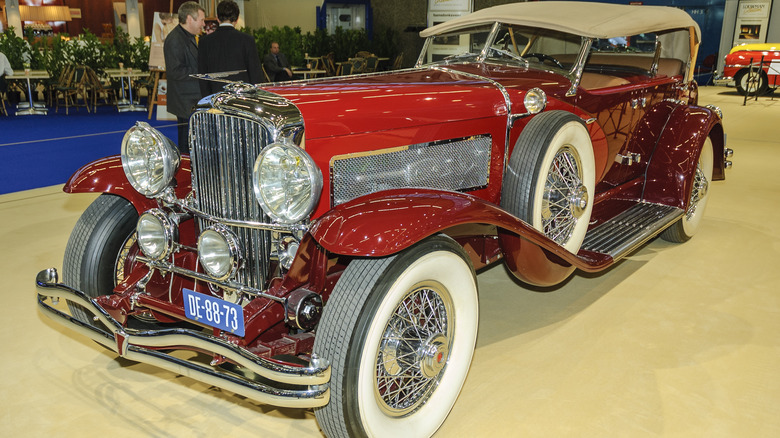5 Of The Most Powerful Pre-War Car Engines Ever Built
Automotive technology has advanced quite a bit since the days of Carl Benz's Patent Motorwagen and the one-cylinder engine. The Ford L-head T-4 that powered the Model T helped that car bring automobiles to the masses, and automakers worked diligently to refine engine power and efficiency when the Model T went out of production after 1927. In 1908 — The Model T's first year of production — the Association of Licensed Automobile Manufacturers developed a formula to calculate engine horsepower, but it was a fixed calculation based on bore size and number of cylinders and not an accurate output measurement. While many modern four-cylinder engines can produce over 300 hp, Road and Track dyno tested a 1915 Model T engine at just under 13 horses.
In an era when you'd likely see 13 actual horses while going about your day, that was a suitable output for an automotive engine. Cars gradually got more sophisticated and potent as the years wore on, but no engine made before World War II was anywhere near as powerful as a typical modern engine. That's not to say that carmakers weren't constantly striving to eke the most out of those early engines, and in a few cases they succeeded in producing some formidable powerplants.
1910 Chadwick Model 19 - 75 horsepower
Just two years after the first Model T left the assembly line, Purdue University engineering student Lee Sherman Chadwick designed and built roughly 300 Model 19 convertibles with a 706 cubic inch (11.1 liter) I6 engine that produced 75 horsepower at just 1,100 rpm. While that number seems modest by modern standards, it was more than three times as powerful as the Model T's engine and robust enough to get the Chadwick Model 19 to a top speed of 96 miles per hour.
To accomplish this, the engine used a three-block architecture with two valves per cylinder. The intake valves were mounted in the heads and exhaust valves were on the sides of each cylinder. A copper cover with water passages inside sat atop each two-cylinder block to cool the engine, and power went to the rear wheels via a four-speed transmission. Chadwick only made 35 cars in 1910, and it's believed that only two survived until today. Even back then, the Chadwick Model 19 was a toy for the elite. It carried a price tag of as much as $6,500, which is equal to more than $200,000 today.
1912-14 Mercedes-Benz 82/200 - 200 horsepower
Beginning in 1912, Mercedes-Benz built the 82/200, which took engine design and performance to unheard-of levels with its gargantuan 21-liter inline four-cylinder engine that produced 200 hp. The engine was adapted from those used in airships at the time, and each cylinder had a single intake valve at the side and a lone exhaust valve on top. Fitting the massive engine in a motorcar involved a long chassis with an extended front end. The 82/200 was almost twelve and a half feet long and sat on a wheelbase of more than nine feet.
The use of aluminum to build the car's body kept its weight to a little over 2,700 pounds and allowed it to reach a top speed of 106 miles per hour, which was faster than the era's airplanes and trains. Reining in that power was a challenge via the brake system, which slowed the rotation of the transmission's input shaft and not the wheels. A chain-drive system sent power to the rear wheels, and the 82/200 stayed in production through 1914. It sold for 36,000 marks, which converted to about $8,510 at the time. Accounting for more than a century of inflation brings that value up to almost $267,000.
1928-30 Bentley Speed Six - 200 horsepower
Bentley is known today as the maker of luxurious performance cars like the Continental GT, which gets an all-new 771-hp hybrid V8 in its next update. Bentley has been doing its thing for more than a century, though. Its pre-war cars were as impressive as its current ones. Bentley's racing history dates back to 1921, when the automaker entered its first car in the 24 Hours of LeMans. Bentley won the legendary endurance race every year from 1927 to 1930, taking the top four spots in 1929. Woolf Barnato and Henry Birkin won that year in a Bentley Speed Six, setting a new distance record for the race by completing 174 laps.
It was the second of three straight LeMans wins for Barnato, who was Bentley's biggest shareholder at the time. The 6.6-liter inline six-cylinder engine in the racing spec Speed Six produced 200 hp, and a production version with an output of 180 hp was made between 1928 and 1930. During that span, only 182 units were produced, and in March of 1930, Barnato and Dale Bourne beat France's Blue Train from Cannes to Calais in a Speed Six, driving all night over unimproved roads at an average speed of more than 43 mph.
Cadillac V16 - 165 horsepower
Around the same time Bentley dominated at LeMans with its beefy straight six, Cadillac was making auto engineering history by introducing the industry's first production car with a V16 engine. That 7.4-liter (452 cubic inch) motor was first used in the 1930 Series 452, which sold 2,500 units that year despite being released on the heels of the stock market crash that kicked off the Great Depression. Cadillac's V16 produced 165 horsepower at 3,400 rpm and a peak of 320 pound-feet of torque at just 1,400 rpm.
The series 452 had an electric starter and the engine featured a newly designed overhead valve system with automatic lash adjustment. Cadillac boasted that this valvetrain was so quiet that drivers could hear the ignition points making contact inside the distributor. The Depression and emergence of Cadillac's own V12 engine put a dent in the sales of V16-equipped cars as the '30s wore on, but Cadillac still engineered a new V-16 with a wider angle between the two banks of cylinders for 1938.
Duesenberg Model SJ - 320 horsepower
Duesenberg Motors had a short run in the auto industry but produced some of the most stunning cars in history. "Doozies" weren't all for show though and boasted some engines that rival modern-day powerplants in terms of output. Duesenberg introduced the Model J in 1927 with a 265-hp straight eight engine, and added the supercharged Model SJ in 1932. That first year, the engine was outfitted with individual rigid exhaust pipes for each cylinder, which would glow from the heat of the gases that flowed through them. The next year, they were replaced with a set of four flexible stainless steel pipes that could be disconnected to give the SJ's engine a louder note and a boost beyond the stock 320 horsepower.
That was enough to get the SJ up to 140 miles per hour, which was more than 35 mph faster than the average speed of the winning car at that year's Indy 500. Duesenberg only made 36 Model SJs during the model's run from 1932 to 1937, but sold them to famous (and infamous) luminaries like Greta Garbo, Howard Hughes, and Al Capone. If you can find one of these magnificent machines today, be prepared to pay in the neighborhood of $2-2.5 million.
